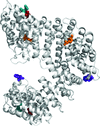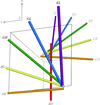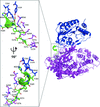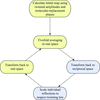issue contents
June 2016 issue

Cover illustration: In this issue a paper by Malinska & Dauter (p. 770) presents the advantages of using the transferable aspherical atom model of macromolecular structure refinement against ultrahigh-resolution X-ray data over the classic independent-atom model approach in terms of final crystallographic statistics, the description of atomic displacement parameters and the quality of electron-density maps. The difference between the electron distributions described by the two models is called the deformation density and it represents changes in the charge-density distribution resulting from simplifications of the spherical atom model. This figure shows a three-dimensional deformation map drawn at values of +0.03 e Å-3 (blue isosurface) and -0.03 e Å-3 (yellow isosurface) for N-{N-[2-(3,5-difluorophenyl)acetyl]-(S)-alanyl}-(S)-phenylglycine tert-butyl ester (DAPT).
scientific commentaries
research papers
 access
access

 journal menu
journal menu





























